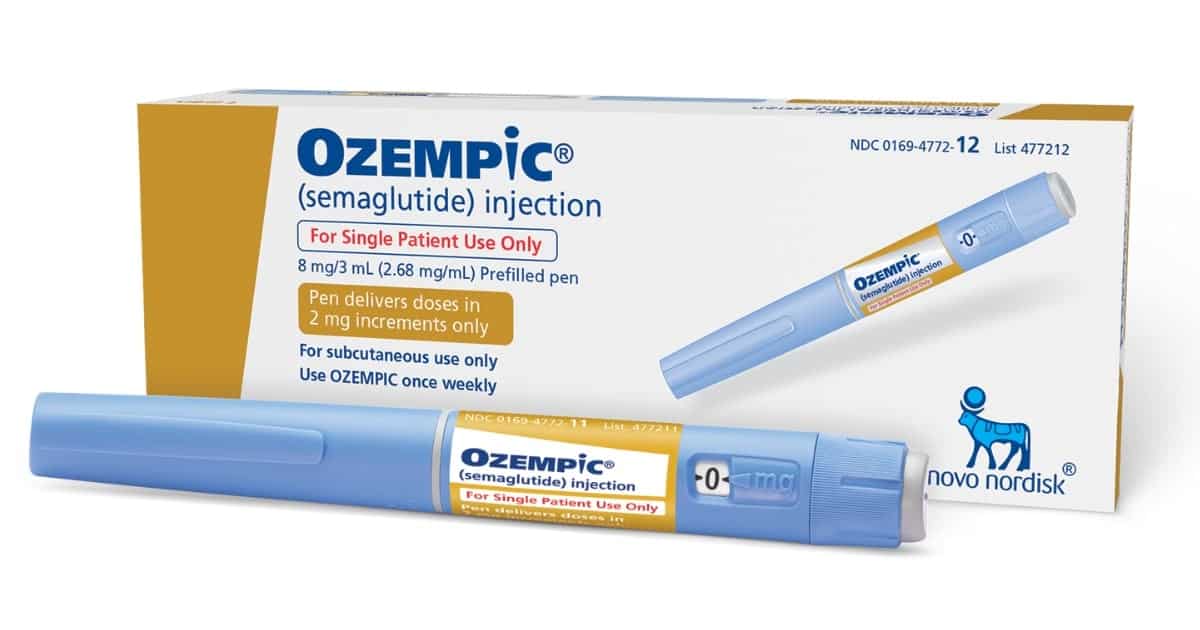Ozempic is a popular type 2 diabetes medication that lowers blood glucose (sugar), improves A1c levels (a measure of glucose control over the previous 2 to 3 months), and helps weight loss or maintenance.

Key Facts
- Ozempic is a once-weekly injectable medication for type 2 diabetes that helps lower blood sugar and A1c levels.
- Benefits include improved blood sugar management, weight loss or maintenance, and a reduced risk of cardiovascular events.
- Side effects range from common nausea and diarrhea to rare severe risks like thyroid tumors and pancreatitis.
Table of Contents
- What is Ozempic?
- What are the benefits of Ozempic?
- Why would you be prescribed Ozempic?
- What are the side effects?
- Dosages
- How much Ozempic should I be taking?
- What happens if you take too much Ozempic?
- Can I miss a dose?
- How to inject Ozempic
- Who shouldn’t take Ozempic?
- How do I stop taking Ozempic?
- How does Ozempic improve diabetes management?
- Can Ozempic replace insulin?
- Can I take Ozempic with other diabetes medications?
- Ozempic and diet
- Does Ozempic need to be refrigerated?
- What does Ozempic cost?
- How do I get a prescription?
What is Ozempic?
Ozempic (semaglutide) is the brand name for a glucagon-like peptide-1 (GLP-1) agonist approved by the U.S. Food and Drug Administration (FDA) to help manage blood sugar levels in adults with type 2 diabetes, alongside diet and exercise.
This injectable medication is taken just once a week due to its long-lasting effects.
What are the benefits of Ozempic?
Ozempic offers three main benefits for people with diabetes:
Improved blood sugar management
The medicine lowers blood sugar and A1c levels by increasing insulin production from the pancreas and reducing the release of glucagon (a storage form of glucose) from the liver.
“I don’t experience vicious high blood sugars as often now, and when I do, they are less ‘sticky’ — they don’t stay high for as long, and the crash down isn’t as severe.“
Stevie Cook, T1D (read about Stevie’s experience with Ozempic)
Weight loss or maintenance
Ozempic helps users lose or maintain weight by decreasing appetite and slowing digestion. Clinical trials with the typical dose show an average weight loss of 4 to 5 percent.
(Wegovy, another semaglutide-based medication approved specifically for weight loss, uses higher doses and results in an average weight loss of 14.9 percent.)
Ozempic is also prescribed “off-label” for weight loss in people with type 1 diabetes or those without diabetes.
Lower risk of cardiovascular disease
Ozempic reduces the risk of major heart events like heart attack, stroke, and death in adults with type 2 diabetes and heart disease.
Why would you be prescribed Ozempic?
Ozempic is FDA-approved specifically for people with type 2 diabetes. Not everyone with type 2 diabetes will be prescribed Ozempic, as many can manage their blood sugar levels with diet, exercise, and sometimes insulin therapy or other medicines.
However, if you’re having difficulty maintaining blood sugar levels within a healthy range with your current medications, or if you’re dealing with insulin resistance, your doctor may prescribe Ozempic as a supplement to your treatment plan.
Additionally, many people with type 2 diabetes and existing heart disease are prescribed Ozempic because it helps reduce the risk of stroke, heart attack, and premature death in this population.
What are the side effects?
Common side effects include:
- Nausea
- Vomiting
- Diarrhea
- Stomach pain
- Constipation
- Weight loss
- Low blood sugar (especially if you’re on insulin)
Rare but serious complications may include:
- Thyroid tumors (including cancer)
- Pancreatitis
- Vision changes (worsening of diabetic retinopathy)
- Kidney problems
- Severe allergic reactions
Seek immediate medical attention if you experience a fever, worsening vision, weakness, or pain after taking the medication.
Learn more in: Ozempic Side Effects: What You Need to Know.
Dosages
Ozempic is available as a liquid solution in prefilled, disposable pens for subcutaneous (under-the-skin) injection, taken once weekly, with or without food.
The pens come in various strengths:
| Pen Strength | Dose Given Per Injection |
| 2 mg/1.5 mL (1.34 mg/mL) | 0.25 mg or 0.5 mg |
| 2 mg/3 mL (0.68 mg/mL) | 0.25 mg or 0.5 mg |
| 4 mg/3 mL (1.34 mg/mL) | 1 mg |
| 8 mg/3 mL (2.68 mg/mL) | 2 mg |
How much Ozempic should I be taking?
Your dosage will vary based on your health history and goals. Most doctors start with 0.25 milligrams (mg) once weekly, increasing to 0.5 mg after a few weeks if well-tolerated.
If needed, your dose may be increased to 1 mg, up to a maximum of 2 mg weekly. It’s important to take Ozempic on the same day at the same time each week.
See more in: Ozempic Dosage Guide: How Much Should You Take?
What happens if you take too much Ozempic?
Overdosing can lead to serious side effects, including severe nausea, vomiting, diarrhea, stomach pain, and dangerously low blood sugar (hypoglycemia), especially if you’re also on insulin.
These conditions can be life-threatening if not treated immediately. If you’ve taken too much Ozempic, contact your doctor or seek emergency medical attention right away.
Can I miss a dose?
If you miss a dose, you can take it within a few days. However, if it has been more than 5 days, skip the missed dose and continue with your next scheduled dose.
One missed dose won’t cause insulin resistance or weight gain, but try to avoid missing doses regularly, as the medication works best when taken consistently.
How to inject Ozempic
Before injecting, check the liquid in the pen for particles or discoloration — if present, do not use the pen.
Clean the injection site with rubbing alcohol, and rotate injection sites weekly to prevent skin injury.
Ozempic is typically injected under the skin in the thigh, abdomen, or upper arm. Speak with your healthcare provider about the best injection sites and rotation techniques.
See more in: Ozempic Injection: Where and How to Inject.
Who shouldn’t take Ozempic?
Only take Ozempic if prescribed by a doctor. It’s not recommended if you are pregnant, planning to become pregnant, or breastfeeding.
Avoid using Ozempic if you don’t have diabetes, or if you have prediabetes or type 1 diabetes without a physician’s guidance.
Do not use Ozempic if you or your family members have a history of medullary thyroid carcinoma (MTC) or Multiple Endocrine Neoplasia syndrome type 2 (MEN 2).
Additionally, avoid Ozempic if you’re allergic to semaglutide. If you’re allergic, you might consider Victoza, which contains liraglutide, another GLP-1 agonist.
How do I stop taking Ozempic?
You might consider stopping Ozempic due to side effects, cost, or how it makes you feel.
However, always speak to your doctor before discontinuing any diabetes medication. Your provider will likely recommend tapering the dose rather than stopping abruptly.
Be aware that stopping Ozempic may lead to a return of insulin resistance, increased blood sugar levels, food cravings, and weight gain.
It’s important to have an alternative plan in place, such as a different medication, exercise, or diet strategy, to manage these effects.
How does Ozempic improve diabetes management?
Ozempic helps manage diabetes by lowering blood sugar levels and supporting weight loss or maintenance, making it easier to achieve and maintain lower A1c levels.
Studies have shown that lower A1cs are associated with a reduced risk of long-term diabetes complications.
By addressing insulin resistance, Ozempic helps stabilize blood sugar, and the associated weight loss can make physical activity more manageable.
Additionally, the drug reduces the risk of heart attack, stroke, and premature death in people with type 2 diabetes and heart disease, significantly improving overall health outcomes.
Can Ozempic replace insulin?
No, Ozempic is not a substitute for insulin.
If you’ve recently been prescribed Ozempic, do not stop taking your other diabetes medications unless directed by your doctor. While Ozempic lowers blood sugar over time, it does not cause the rapid reduction in blood sugar that insulin does.
If you typically take insulin with meals, you’ll need to continue doing so. After several months on Ozempic, you might notice a decrease in your insulin needs, but it’s unlikely that you’ll be able to completely stop using insulin for your diabetes management.
Can I take Ozempic with other diabetes medications?
Yes, Ozempic can be taken with other diabetes medications like metformin, insulin, and others.
However, always consult your doctor to ensure it doesn’t conflict with any medications you’re currently taking. Make sure your doctor is aware of all the medications you use before starting Ozempic.
It’s important to note that Ozempic should not be combined with other GLP-1 agonists like Wegovy, Victoza (liraglutide), Trulicity (dulaglutide), or Mounjaro (tirzepatide), as this can be dangerous.
Ozempic and diet
When taking Ozempic, it’s important to be mindful of how certain lifestyle choices, such as alcohol consumption and diet, can affect your treatment and overall health.
Understanding the interactions between Ozempic and alcohol, as well as knowing which foods to avoid, can help you manage your diabetes more effectively and reduce the risk of adverse effects.
Learn more in: Ozempic and Alcohol: Can You Drink While Taking Ozempic? and Foods to Avoid While Taking Ozempic.
Does Ozempic need to be refrigerated?
Yes, Ozempic should be stored in the refrigerator at a temperature between 36°F and 46°F (2°C and 8°C). Once opened, it can be used for up to 56 days.
What does Ozempic cost?
The amount you’ll pay each month, known as your co-pay, varies depending on your insurance plan. To determine your specific co-pay, use your prescription or medical card and the Ozempic coverage and co-pay calculator.
As a diabetes drug, Ozempic is widely covered by major health plans, including Medicare and Medicaid (it is not covered for weight-loss purposes).
If you have any questions regarding coverage or co-pay costs, you can contact Ozempic support at 1-833-OZEMPIC (1-833-693-6742).
For those who qualify, the Patient Assistance Program (PAP) offers free medication. To learn more about this program, call Novo Nordisk’s PAP toll-free at 1-866-310-7549.
How do I get a prescription?
Talk to your doctor if you’re interested in a prescription. If you have type 2 diabetes and are dealing with weight loss or insulin resistance, your doctor can prescribe it.
If you have another form of diabetes and are dealing with insulin resistance, discuss your treatment options with your provider.
If you don’t have diabetes and are seeking weight-loss solutions, ask your doctor about FDA-approved weight-loss medications that may be safer and more appropriate than Ozempic.
Did you find this article helpful? Click Yes or No below to let us know!






Apkepoch
Thank you for such a detailed and informative post on Ozempic! I’ve been using Ozempic for a few months now, and I’ve noticed a significant improvement in my blood sugar levels. However, I did experience some mild nausea during the first few weeks. It’s reassuring to read that this is a common side effect and that it usually subsides over time. I also appreciate the tips on how to manage the side effects—those have been really helpful for me. Have others here had similar experiences with the side effects, or found any additional tips that worked for them?
Quincy Cooper
Just started Ozempic 3 weeks ago at 0.25